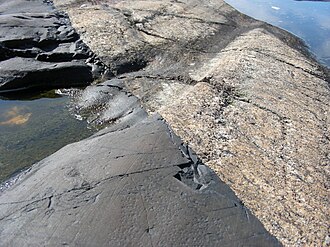Gneiss





Gneiss is a high-grade metamorphic rock characterized by its banded appearance and granular texture. It forms through the high-degree alteration of original rocks, either igneous or sedimentary rocks, under intense heat and pressure conditions deep within the Earth's crust. The process, known as metamorphism, results in the recrystallization of the rock's minerals, leading to the formation of new mineral assemblages that are stable under the conditions of high temperature and pressure.
Formation[edit]
Gneiss forms from the metamorphism of pre-existing rocks in conditions of high temperature and pressure, typically associated with mountain building processes. These conditions allow for the recrystallization of minerals without melting the rock. The process leads to the segregation of minerals into alternating light and dark bands, giving gneiss its characteristic appearance. The light bands are typically composed of quartz and feldspar, while the dark bands contain minerals such as biotite, amphibole, and garnet.
Types[edit]
There are several types of gneiss, classified based on their composition and the conditions under which they were formed. Some of the common types include:
- Orthogneiss: Derived from igneous rock, such as granite.
- Paragneiss: Derived from sedimentary rock.
- Migmatite: Features characteristics of both gneiss and igneous rock, indicating partial melting.
Characteristics[edit]
Gneiss is distinguished by its foliated texture, with minerals arranged into bands or layers. This foliation is a result of the differential stress and high temperatures involved in its formation, which aligns the minerals into sheets. Despite its foliated structure, gneiss does not split as easily as other metamorphic rocks, such as schist, due to its coarser and more granular texture.
Uses[edit]
Due to its strength and durability, gneiss has been used as a construction material for centuries. It is commonly used in building construction, landscaping, and as a decorative stone in architecture. Its resistance to weathering makes it suitable for exterior applications, while its unique banded appearance is valued for interior design projects.
Distribution[edit]
Gneiss is found in regions that have undergone intense metamorphism, often associated with the cores of ancient mountain ranges or the roots of modern mountains. These include parts of the Canadian Shield, the Scottish Highlands, the Himalayas, and the Scandinavian Mountains.
Ad. Transform your life with W8MD's Budget GLP-1 injections from $75


W8MD offers a medical weight loss program to lose weight in Philadelphia. Our physician-supervised medical weight loss provides:
- Weight loss injections in NYC (generic and brand names):
- Zepbound / Mounjaro, Wegovy / Ozempic, Saxenda
- Most insurances accepted or discounted self-pay rates. We will obtain insurance prior authorizations if needed.
- Generic GLP1 weight loss injections from $75 for the starting dose.
- Also offer prescription weight loss medications including Phentermine, Qsymia, Diethylpropion, Contrave etc.
NYC weight loss doctor appointmentsNYC weight loss doctor appointments
Start your NYC weight loss journey today at our NYC medical weight loss and Philadelphia medical weight loss clinics.
- Call 718-946-5500 to lose weight in NYC or for medical weight loss in Philadelphia 215-676-2334.
- Tags:NYC medical weight loss, Philadelphia lose weight Zepbound NYC, Budget GLP1 weight loss injections, Wegovy Philadelphia, Wegovy NYC, Philadelphia medical weight loss, Brookly weight loss and Wegovy NYC
|
WikiMD's Wellness Encyclopedia |
| Let Food Be Thy Medicine Medicine Thy Food - Hippocrates |
Medical Disclaimer: WikiMD is not a substitute for professional medical advice. The information on WikiMD is provided as an information resource only, may be incorrect, outdated or misleading, and is not to be used or relied on for any diagnostic or treatment purposes. Please consult your health care provider before making any healthcare decisions or for guidance about a specific medical condition. WikiMD expressly disclaims responsibility, and shall have no liability, for any damages, loss, injury, or liability whatsoever suffered as a result of your reliance on the information contained in this site. By visiting this site you agree to the foregoing terms and conditions, which may from time to time be changed or supplemented by WikiMD. If you do not agree to the foregoing terms and conditions, you should not enter or use this site. See full disclaimer.
Credits:Most images are courtesy of Wikimedia commons, and templates, categories Wikipedia, licensed under CC BY SA or similar.
Translate this page: - East Asian
中文,
日本,
한국어,
South Asian
हिन्दी,
தமிழ்,
తెలుగు,
Urdu,
ಕನ್ನಡ,
Southeast Asian
Indonesian,
Vietnamese,
Thai,
မြန်မာဘာသာ,
বাংলা
European
español,
Deutsch,
français,
Greek,
português do Brasil,
polski,
română,
русский,
Nederlands,
norsk,
svenska,
suomi,
Italian
Middle Eastern & African
عربى,
Turkish,
Persian,
Hebrew,
Afrikaans,
isiZulu,
Kiswahili,
Other
Bulgarian,
Hungarian,
Czech,
Swedish,
മലയാളം,
मराठी,
ਪੰਜਾਬੀ,
ગુજરાતી,
Portuguese,
Ukrainian
